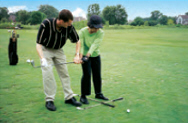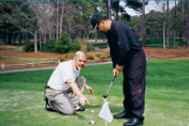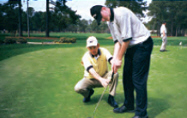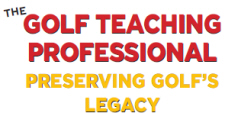Preserving Golf’s Legacy
Everyone can recall a favorite high-school teacher. Algebra? Chemistry? French? Surely it wasn’t equations, formulas or verb conjugations that made the most memorable impression.
Most likely the nostalgia one feels when remembering a favorite teacher stems from that individual’s passion for teaching, love and mastery of the subject matter and, perhaps most importantly, commitment to students – their learning, progress and understanding. Most golfers have similar memories of whoever introduced them to golf or guided them toward reaching their potential. For many, it was a parent who first placed a club in their hands, and it was a club pro or local instructor who took it from there, flaming the spark of a lifelong love of the game. Teaching long has been considered a noble profession the world over, and golf instruction fits the niche.
most importantly, commitment to students – their learning, progress and understanding. Most golfers have similar memories of whoever introduced them to golf or guided them toward reaching their potential. For many, it was a parent who first placed a club in their hands, and it was a club pro or local instructor who took it from there, flaming the spark of a lifelong love of the game. Teaching long has been considered a noble profession the world over, and golf instruction fits the niche.
Where does the nobility lie? Wiggly six-year-olds present a particular challenge, as do adults experiencing their first exposure to golf, often intimidated by the game’s physical challenges and mysterious protocols. Some players, entrenched in their habits, need a knowledgeable eye, yet may be too proud to submit to swing observation or analysis. There are some young people and adults whose lives never have intersected with golf, by virtue of economics or social background, yet who yearn to take up the game against great odds. Disabled individuals, older folks, college-bound players, skilled amateurs, tour pros… all present customized instructional needs and require great patience and dedication.
Therein lies the nobility of golf instruction. The inherent challenge and reward of successful teaching go hand in hand, as in any worthwhile endeavor. There’s more, though. Golfers who decide to take lessons, whether periodically or frequently, experience renewed commitment and enjoyment, which often radiates to friends, family and playing partners. The effect is anything but finite. Golf teaching professionals are the game’s greatest ambassadors.
History Lessons: Insights on Golf Instruction Still Reverberate
Most golfers are students of the game in one fashion or another. Some can recite famous tour players’ record-breaking statistics; others discuss their golf travel adventures. Almos
t all players, though, love to share their finest exploits on the course: a new personal record, a birdie here, an amazing putt there. In their never-ending quest for game improvement (and bragging rights), they look for playing tips everywhere: in magazines, videos, television, radio, conversations with friends. Avid golfers, in their ongoing desire to fine-tune their games, tend to seek advice from credentialed golf instructors. There is a sense of trust and comfort in relying on the knowledge and expertise of a professional, whose teaching skills rest not only on experience and contemporary techniques, but also on voices from the past.
“Golf tips are like aspirin,” said celebrated golf teacher Harvey Penick (1904-95). “One may do you good, but if you swallow the whole bottle you will be lucky to survive.”
Golf teaching professionals know how to mete out advice in precise measure according to the needs of each particular player. Students sense this and appreciate it, sharing with their instructors the thrill of tangible, measurable improvement. It was also Harvey Penick who said, “I received as much joy from coaxing a first-time pupil, a woman from Paris, into hitting the ball into the air so that she could go back to France and play golf with her husband as I did from
watching the development of all the fine players I have been lucky

enough to know.”
Many memorable observations on golf instruction and philosophy were spoken by renowned players as well as by teachers. The great Ben Hogan (1912-97) said, “The ultimate judge of your swing is the flight of the ball,” and “The most important shot in golf is the next one.”
As for the invaluable merit of professional golf instruction and playing experience, perhaps PGA Tour player Tony Lema (1934-66) said it best: “You’re not going to find a golf swing in a book.”
 USGTF Instructors: Enhancing Golfers’ Games and Lives
USGTF Instructors: Enhancing Golfers’ Games and Lives
As they share their passion every day with new generations of players, golf instructors worldwide contribute significantly to growing the game and ensuring its continuity far into the future. United States Golf Teachers Federation instructors comprise a notable portion of this important segment of the golf industry. While their individual stories differ, USGTF instructors have as a common bond a true and genuine love of teaching.
“I like teaching beginners because they have nothing to unlearn,” says Bill Rice, a 15-year member of USGTF who is a master instructor and course examiner. “And I like teaching accelerated players because I help them see things they cannot see.”

Rice, 66, is an artist and a retired public school educator. He taught art, and served as an assistant high school principal and adult education program director. As a lifelong educator, he sees his role as a golf instructor at the Las Vegas Golf Club as a natural extension of his prior experience. Among his students are youngsters involved in The First Tee of Southern Nevada.
“My philosophy of teaching is to help players do what their bodies do naturally in order to simplify the swing,” says Rice, who enjoys meeting and teaching people from various countries and cultures, broadening horizons along the way.
Steve Williams, also a 15-year USGTF member, once had a different dream.
 “From the first time I hit a club, I wanted to be a touring pro,” says Williams, 54, who owns, directs and teaches at The Texas Golf Academy in Houston. “My dad introduced me to golf when I was 12 years old, and those times are among my fondest memories.”
“From the first time I hit a club, I wanted to be a touring pro,” says Williams, 54, who owns, directs and teaches at The Texas Golf Academy in Houston. “My dad introduced me to golf when I was 12 years old, and those times are among my fondest memories.”
Williams realized his dream by playing the minitours for several years, until a previous back injury caused him to reassess his goals and turn to teaching full-time. He adheres to no particular teaching method, choosing instead to help students, including some tour players, reach their potential through customized goal setting and instruction. A USGTF examiner, Williams feels he was “born to work with others,” thereby extending his passion for golf and affecting lives.
Students’ enthusiasm is contagious, according to David Vaught, who serves as director of instruction at San Luis Downs Golf-Tennis Resort and Country Club near San Diego. Vaught, 47, is a USGTF advisory board member, a Master Golf Teaching Professional and a national course examiner, as well as a PGA member. He enjoys teaching all ages and levels of players, including a US Women’s Mid-Amateur champion.
“I’d have to say my favorite is teaching beginners,” Vaught says. “They have more of a clean slate and their expectation level is lower. They are thrilled to get the ball in the air, and I am thrilled for them.”
Vaught is encouraged about the future of golf, as he sees an ever-increasing emphasis on bringing new players into the game and making it more enjoyable for everyone. Among the greatest challenges in teaching, Vaught believes, is communication – keeping things simple and easy to understand.
“Golf is instinctive and natural to us who teach it every day of the year,” says Vaught. “My objective for my students is three-fold: Remember, understand, apply.”

 USGTF Master Golf Teaching Professional Tom Buckley believes his responsibility as a golf instructor is “to be a trusted servant, not a fearless leader.” His goal is to provide all he can to each individual learner to assist in skill improvement and love of the game. Although he likes teaching players of all ages and skill levels, Buckley, 67, especially enjoys teaching juniors at Brambleton Golf Course in Ashburn, Virginia.
USGTF Master Golf Teaching Professional Tom Buckley believes his responsibility as a golf instructor is “to be a trusted servant, not a fearless leader.” His goal is to provide all he can to each individual learner to assist in skill improvement and love of the game. Although he likes teaching players of all ages and skill levels, Buckley, 67, especially enjoys teaching juniors at Brambleton Golf Course in Ashburn, Virginia.
“I am fortunate,” Buckley says, “to have the opportunity to teach some outstanding young players, one of whom went on to play college golf and is preparing for Q-School.” Buckley also has taught special-needs people, including a Down-Syndrome individual who won a golf medal in a Special Olympics event in California.
Buckley is concerned about the growth of golf, as it seems to him that just as many people are leaving the game as entering.
“I believe it is the supreme responsibility of golf teachers to help grow the game,” says Buckley. “Despite all the new technology and instructional materials, we need to do more. We need to help people understand that learning golf is a lifelong process.”
Michael Wolf, USGTF member and director of golf at Oak Meadow Golf Club in Evansville, Indiana, believes golf teachers play a positive role in students’ lives. Whether with group or individual instruction, Wolf, 50, strives to let players understand that he cares about their success.
“Helping golfers see improvement in their games enhances their quality of life,” Wolf says. “We can help promote golf’s future. It is a gift to pay it forward.”
Wolf’s own introduction to golf was unusual. As a 14-year-old lover of baseball whose only exposure to golf had been what he had seen on television, Wolf had his 10-speed bicycle stolen. He decided to buy golf clubs instead of replacing his bicycle. He caddied at his local club, encouraged by head golf professional and later-renowned instructor Chuck Cook.
 “Chuck didn’t charge me for his help,” says Wolf. “The free instruction and encouragement he gave me made me want to be a golf teacher. So much of golf, and of life, is a spin-off of things that we experience.”
“Chuck didn’t charge me for his help,” says Wolf. “The free instruction and encouragement he gave me made me want to be a golf teacher. So much of golf, and of life, is a spin-off of things that we experience.”
Wolf, 50, is the author of The Driven Golfer, first published in 2006 and since updated with DVDs and additional information. His philosophy of teaching entails the understanding that everyone is different athletically, and that instruction should involve taking into account varying physical capabilities while incorporating the “Golden Rules of Golf” for all.
“I thank my students for the opportunity to work with them,” Wolf says. “This is no small thing.”
For John Savage, USGTF Master Golf Teaching Professional and head golf professional at Mad Golfer Golf Club in Southampton, Pennsylvania, kinetics is the focus. Precise analysis of the golf swing allows him to help students hone their movement.
Savage’s foray into golf was as a caddie, beginning at age 10. When he was 12 he had his first golf lesson, “from an old Scotsman named Al McDonald,” recalls Savage. “I was swinging out of my shoes.”
Today Savage’s philosophy of teaching is “…to know it so well that you don’t have to explain it. The best way to teach is to understand that muscles don’t remember words. It’s all about ‘picture and feel.’”
Savage counts among his students blind golfers and amputees, whom he teaches free of charge, working with the Blind Golfers Association and the Veterans Administration for Amputees.
 “It’s satisfying,” says Savage, 73. “I learn as much from them about balance as they learn from me about golf.”
“It’s satisfying,” says Savage, 73. “I learn as much from them about balance as they learn from me about golf.”
The distinguished individual efforts of USGTF instructors are augmented and highlighted by such well-known events as the World Golf Teachers Cup and the National Golf Teachers Appreciation Day, during which golfers show their appreciation and instructors reciprocate by donating a lesson fee that day to the charity of their choice.
Golf Teaching Professionals: The Ripple Effect
The individuals who make up all the facets of golf are myriad, from players to greenskeepers, golf-course architects to chefs, caddies to club managers. Where do golf teaching professionals fit into the mosaic?
Touring professionals, due to their collective visibility and exposure, are famous, receive many accolades and are compensated handsomely for their success. Yet their passion and commitment are no greater than those of golf teaching professionals. While many players aspire to mastery of the game or even greatness, golf instructors aspire to helping others achieve their dreams, no matter how humble. In teaching the game they love, instructors often accomplish other extemporaneous things: enhancing enjoyment of a family vacation, encouraging a discouraged player, mending a fragile golf ego, evoking a smile, instilling renewed confidence or implanting a lifelong devotion to golf. The opportunity to do all these things is everpresent to golf teaching professionals. Their passion for the game and for teaching unites them worldwide, and their stories continue to unfold.
Sally J. Sportsman, a USGTF contributing writer, lives in Orlando, Florida





